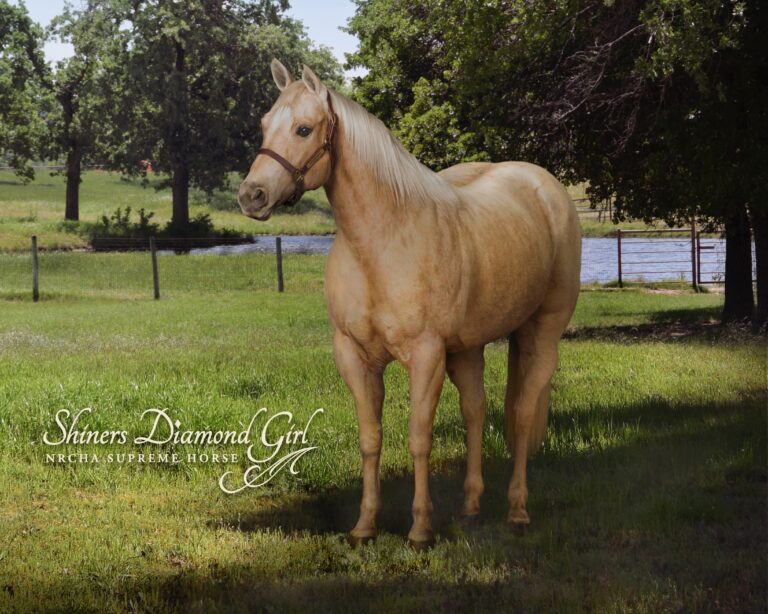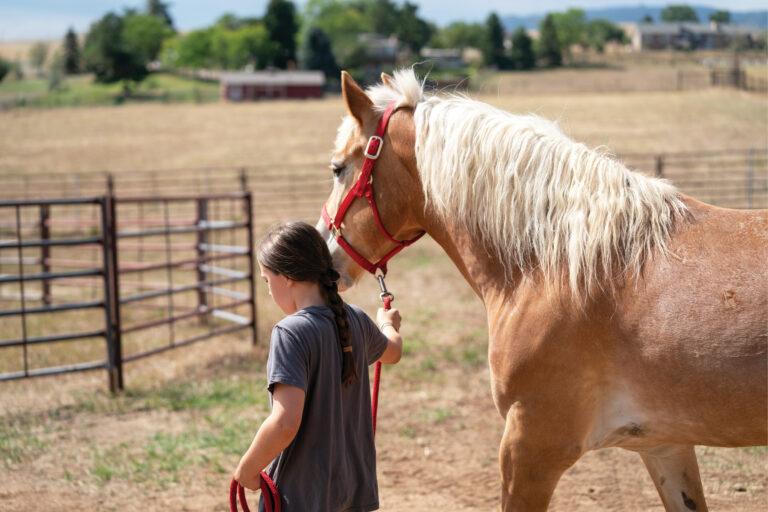Gypsy Vanners have become a fan favorite in the equestrian community, thanks to their unique features, paired with their endearing, friendly temperament.
I confess: I was born a Western stock-horse snob. Other than the pony I took my first lesson on, my mounts consisted of Quarter Horses, Paints, and a lone Appaloosa. Being a predominantly Western rider, this made sense to me—I naively felt I had no reason to consider any other breed. Sure, I could see the beauty in a Thoroughbred racing down the track at the Kentucky Derby or a warmblood traversing a cross-country course, but I never thought owning anything other than a stock horse was for me.
That’s until recently, when my friends and I started getting curious about a breed we were surprised to see in Western tack. One that’s relatively new to the United States (they were first imported in the mid 1990s), requires even more grooming than our mane-gifted reining horses, has a distinctly draft look but also does great under a Western saddle, and reminds us of the fantasy dramas we enjoy watching on TV.
So, what’s our newest obsession?
The Gypsy Vanner. And it seems we’re not alone in our interest in this stocky, medieval-looking steed—according to the Gypsy Vanner Horse Society, the breed’s official registry, the breed’s presence has grown year after year. As further evidence of their popularity, they top many sales’ lists of high sellers.
Here, I’ll share insights provided by in-the-know Gypsy Vanner owners, breeders, and trainers to help answer all your Gypsy Vanner questions that could help you decide if the breed is a good fit for your Western horse life.
Read More: How Many Horse Breeds Are There?
Origin of the Gypsy Vanner
These horses come by their breed name naturally. The British Gypsies spent years crossing draft horses to create the perfect animal to pull their dynamic caravans, hence Gypsy in homage to the breed’s founders and Vanner in reference to the “vans” the horses pull. Genetically, the steeds trace to Shires, Clydesdales, and native British ponies called Dales. Most stand 14 to 15 hands high, and you’ll see them in solid, tobiano, and “slash” coat patterns.

Most people first notice the long, flowing feather (yes, singular) that sprouts behind the horses’ knees and hocks and cascade down the backs of their cannons to their hooves, the flowing manes and tails, and even the “mustaches” that can grow from their muzzles. These distinct physical characteristics, paired with their endearing, friendly temperament, draw experienced equestrians and newcomers alike to the breed. To top it off, Vanners’ use goes beyond pulling carts. Today, you’ll see them everywhere from the dressage ring to trail riding.
A Magnetic Draw
Professional horse trainer and Horse&Rider OnDemand contributor Tim Christensen, Ocala, Florida, built his career in the Quarter Horse business, earning numerous AQHA Year-End High-Points and Western dressage world championships alongside his family’s horses winning All American Quarter Horse Congress and AQHA World Championship Show titles. He admits that, like many who participate in that part of the industry, he might’ve
had tunnel vision for stock horses.
“We might not have paid much attention to other breeds,” Christensen shares. “But we got into Western dressage, and a few years ago, a customer fell in love with a Gypsy Vanner she watched show online. She gave me the horse’s back number and asked me to find out how she could buy that horse, and it started a fascination in her.”
Christensen hadn’t been around the breed, but quickly developed a fondness for Gypsy Vanners for their “healing properties” and incredible trainability (more on that later).
“They’re horses that want to please you,” he says.
Alex Bauwens, horse trainer/broker and social media influencer based in Scottsdale, Arizona, found a love for Gypsy Vanners as a child.

Alex Bauwens found a love for Gypsy Vanners as a child but didn’t have the chance to ride one until later in her riding career. She enjoys the breed’s versatility and does everything from trail riding to mounted archery on Gypsy Vanners. Photo by Vanessa Hughes.
“I’d see them at fairs, and I was instantly obsessed,” she says. “I called them ‘horses with dogs on their feet’ as a kid [because of the feathered legs]. When I started training horses, a woman in my barn had a Gypsy Vanner, and I was absolutely in awe. I rode that horse for the first time six or seven years ago. I found them very kind, willing, and trainable.”
Kandee Bassett had a long tenure showing Saddlebreds, but after a 16-year hiatus from horses, she found herself with a 65-acre horse farm and a need for a quieter horse life than the one she had when she was younger. The motivational speaker was visiting Lake Tahoe and set out looking for a Gypsy Vanner farm, where she had her first encounter with the breed.
“I received a call 10 days later from a woman who said she’d heard I was looking for a Vanner, and she needed to re-home hers,” Bassett remembers. “I was looking for a lifetime horse, and she wanted him to go to a great home. He was a remarkable animal, and I spent 10 years with him. He started it all—my farm, Big Sexy Stables, is named after him. They’re so easy to train and work with; they want to be in your pocket.”
What do our experts think you should know before you consider a Gypsy Vanner for your barn? Read on for their key tips.
They’ll Go Anywhere & Do Anything
Bassett, Bauwens, and Christensen all do different things with their Gypsy Vanners, a testament to their versatility and adaptability. Bauwens’ videos of her doing horseback archery on a Vanner have gone viral across the internet, but she also enjoys trail riding with them.
They’re so easy to train and work with; they want to be in your pocket.
Kandee Basett
“I have a few in the barn now, and we do trail riding and light arena work. They’re seriously adaptable and good at picking up new jobs.”
Bassett competes in combined driving events with her Vanners.
“I happened to see my first Vanner pulling a cart, so I bought a cart and harness and gave it a try,” Bassett says. “Now I mainly do driving shows with a pair or I do four-in-hand. The breed has incredible endurance—the Gypsies had these horses pulling 500-pound carts 20 miles a day, so it’s part of their breeding.”
Christensen shows his Vanners, along with other breeds, in Western Dressage Association of America events. At the Gypsy Vanner shows, he exhibits the horses in all the classes, from in-hand trail to in-hand suitability, and has earned numerous top-10 honors.
They’re Very Smart
Intelligence is a positive trait when it comes to training and maintaining horses, and Vanners come with a lot of it. Everyone we spoke with noted their smarts, which makes the horses very trainable. But that comes with a level
of responsibility for the rider.
“They’re incredibly smart,” Bauwens explains. “So much so that they require regular training and maintenance, just like any other horse. But be very careful what you train them. They learn so fast, that it’s very easy to train a bad habit.”
“They’re horses that want to please you,” Christensen agrees. “They’re very smart, and they catch on very quickly. Once they know what you want, they really try to please you.”
They Love to Love
Bassett likens the breed to the Golden Retriever, which is something she desired after being away from horses for
a lengthy time period.
“I’d been out of the horse world for so long, so when I decided I wanted horses again, I wanted a kind, gentle horse that I could bond with,” Bassett says.“I was very drawn to the Vanners’ personality and eagerness to please.”

Christensen agrees, saying, “I hadn’t ever been around them, but I always heard people talk about Gypsy Vanners having incredible healing powers. That’s how many breeders market them, and it’s very true. They want to please you.”
Vanners Like to Climb
Bauwens spends many hours in the deserts surrounding her barn, trail riding her Vanners. One thing she’s noticed: They’re like mountain goats when it comes to climbing.
“Every Vanner I’ve had loves to climb,” she explains. “The most recent one I had tried to climb the mounting block. I let another customer’s Gypsy Vanner get rewarded at the end of a good ride by letting him stand on a large sand mound outside the arena. It’s something to be aware of, but it makes them great on the trail!”
All That Hair Requires Care
The flowing locks might be what draws you to a Gypsy Vanner, but it’s not without commitment to lots of maintenance.
“If you want a Vanner, you’d better like grooming,” Bauwens says with a laugh. “If you don’t want to do a lot of grooming, this horse might not be for you. I spend an hour each week washing and maintaining one horse’s mane and tail.”

The feather on the legs can cause scratches, a skin condition that can become painful and is also known as mud fever or equine dermatitis. The manes are thick and coarse, requiring washing and conditioning. Bauwens keeps her Vanners’ manes braided, too, to avoid rubbing and hair loss. She also advises washing very well at the base of the mane to avoid skin conditions that lead to itching.
“It’s a commitment, but I don’t mind it,” Bassett says. “It’s just part of our day. My horses are so good for bathing and are eager for it. They’d love to stand and be groomed all day. Here in Florida, we keep them body-clipped so they’re more comfortable in our weather. But there’s no doubt—if you don’t want
to deal with hair, this probably isn’t your horse.”
Tack Adjustments Required
Just as with any horse, properly fitting tack prevents injury and increases enjoyment for both horse and rider. Check your saddle fit, and maybe skip the protective legwear to keep the horse’s feather from rubbing.
“People think Vanners look big in photos, but they’re not overly large,” Bauwens says. “I usually choose a wider-tree saddle for a Vanner, but that also depends on the individual.”
Christensen finds that most of his tack fits all of his horses.
“My Western dressage saddles are geared to wider-shouldered horses anyway,” he shares.
Learn More: An Introduction to Western Dressage
Expect Attention
When you take a Gypsy Vanner to a trail ride or show, be prepared to capture a lot of attention.
“They’re one of the most beautiful breeds,” Christensen says. “It’s really fun to educate people about the horses and my experiences with them.”

“People get big eyes and can’t wait to touch them and talk about them—especially if I’m driving a pair of them,” Bassett agrees. “People always want to stop you and learn about them.”
They’re Best for Pleasure
“If you’re an aggressive rider and have a more demanding training style, Gypsy Vanners might not be for you,” Christensen cautions. “They’re very trusting and prefer softer hands in a low-pressure situation. It’s more about the long game with Vanners. They mature physically and mentally at 6 to 7 years old. That’s when their bodies bulk up and their shoulders get wider.”
Bassett agrees with Christensen, but also recognizes that every horse is different.
“I have Vanners that will take you anywhere, riding or driving,” she says. “They have get-up-and-go that they can turn on when the time comes.”
In Bauwens’ experience, Vanners are best for the joy-rider, who wants to have a lot of fun doing things like trail and pleasure riding, Western dressage, and working equitation.






